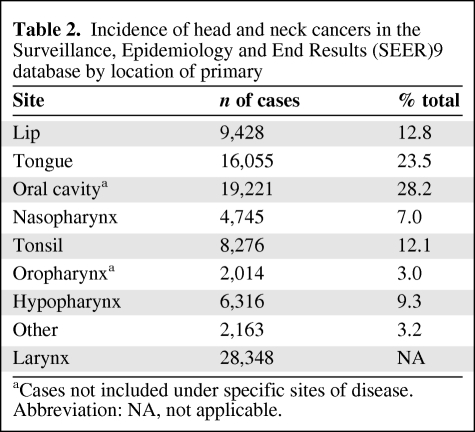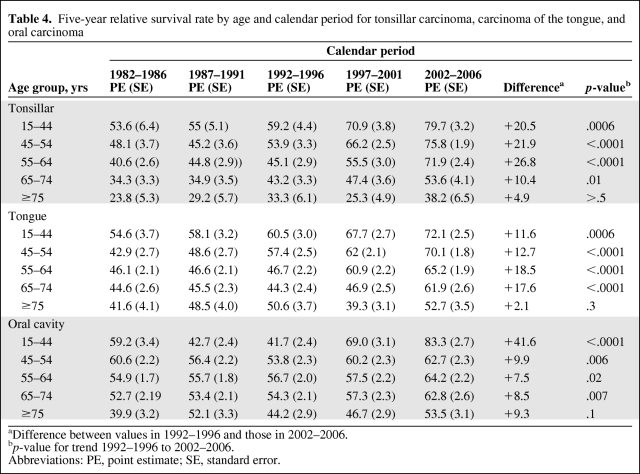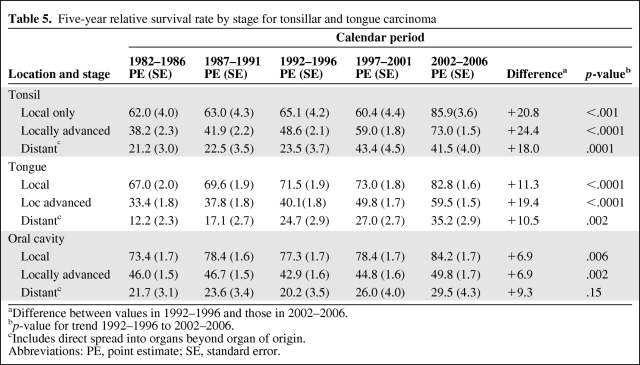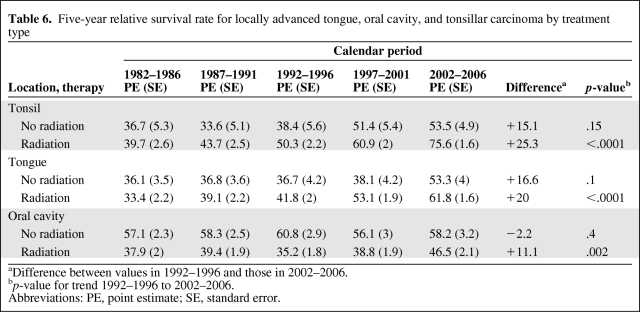Abstract
Background
Therapy for head and neck cancers has evolved over the past decade, but few detailed analyses of recent developments in survival on the population level have been published.Methods
We use period analysis and modeled period analysis to disclose recent trends in survival in patients with head and neck cancer. Data are derived from the Surveillance, Epidemiology, and End Results limited-use database.Results
A major, statistically significant improvement in survival was observed, with the overall 5-year relative survival rate going from 54.7% in 1992-1996 to 65.9% in 2002-2006. Subgroup analysis showed improvement in cancers of the oral cavity, tongue, tonsils, and nasopharynx, with the greatest improvements observed in tonsillar carcinoma (+22.2 percentage points) and carcinoma of the tongue (+14.4 percentage points). Further analysis of survival for oral cavity, tonsillar, and tongue carcinoma revealed improvements in survival at each stage and across all age groups except for patients aged ≥ 75 years, with the greatest improvement occurring in locally advanced disease and in patients aged 55-64 years for carcinoma of the tongue and tonsils and those aged 15-44 years for oral cavity cancers.Conclusions
Survival has substantially improved for head and neck cancer patients over the past decade. The greatest improvement was seen in tonsillar and tongue cancers.Free full text

Changes in Survival in Head and Neck Cancers in the Late 20th and Early 21st Century: A Period Analysis
Abstract
Background.
Therapy for head and neck cancers has evolved over the past decade, but few detailed analyses of recent developments in survival on the population level have been published.
Methods.
We use period analysis and modeled period analysis to disclose recent trends in survival in patients with head and neck cancer. Data are derived from the Surveillance, Epidemiology, and End Results limited-use database.
Results.
A major, statistically significant improvement in survival was observed, with the overall 5-year relative survival rate going from 54.7% in 1992–1996 to 65.9% in 2002–2006. Subgroup analysis showed improvement in cancers of the oral cavity, tongue, tonsils, and nasopharynx, with the greatest improvements observed in tonsillar carcinoma (+22.2 percentage points) and carcinoma of the tongue (+14.4 percentage points). Further analysis of survival for oral cavity, tonsillar, and tongue carcinoma revealed improvements in survival at each stage and across all age groups except for patients aged ≥75 years, with the greatest improvement occurring in locally advanced disease and in patients aged 55–64 years for carcinoma of the tongue and tonsils and those aged 15–44 years for oral cavity cancers.
Conclusions.
Survival has substantially improved for head and neck cancer patients over the past decade. The greatest improvement was seen in tonsillar and tongue cancers.
Background
Head and neck cancers are a heterogeneous group of cancers that arise from the squamous epithelium of the oral cavity and pharynx. Together, this group of cancers is the ninth most common form of cancer in men in the U.S. [1], with an incidence of 14.97 per 100,000 in men and 6.24 in women and an age-adjusted mortality rate of 3.78 per 100,000 in men and 1.39 in women in 2006 [2]. In 2009, 35,720 cases of head and neck cancer and 7,600 deaths resulting from the disease were expected to have occurred [1].
Head and neck cancers have traditionally been considered difficult to cure beyond very early-stage disease. However, recent advances in the use of chemotherapy plus radiation and the use of hyperfractionated radiotherapy have led to longer survival times in clinical trials [3, 4]. However, it is less clear to what extent the improvements in survival observed in clinical trials translate into better survival at the population level. In the current study, we examine recent changes in survival in head and neck cancer patients through the use of period analysis and model-based period analysis.
Methods
Database
All data presented in this paper are derived from the 1973–2006 limited-use database of the Surveillance, Epidemiology, and End Results (SEER) Program of the U.S. National Cancer Institute issued in April 2009 [2]. We used data included in the 1973–2006 SEER9 database, which are from population-based cancer registries in Connecticut, New Mexico, Utah, Iowa, Hawaii, Atlanta, Detroit, Seattle–Puget Sound, and San Francisco–Oakland, and together cover a population of about 30 million people. Geographic areas were selected for inclusion in the SEER Program based on their ability to operate and maintain a high-quality population-based cancer reporting system and for their epidemiologically significant population subgroups.
Cancers of the lip, tongue, oral cavity, oropharnyx, hypopharnyx, nasopharynx, tonsil, and head and neck not otherwise specified were included in the analysis. Cancers of the mouth and gums that were not listed for a more specific site (e.g., tongue) were grouped into the “oral cavity” category. Similarly, cancers were considered to be oropharyngeal if they were not more specifically categorized (e.g., tonsillar). Salivary gland tumors were excluded because they are frequently of different histologies from other head and neck cancers. Cancers of the tongue are considered as a single category because all International Classification of Diseases (ICD) codes relating to the tongue are grouped as a single “recode” group in the SEER database, and changes in the initial ICD codes over the period examined make use of the original ICD codes impractical.
Overall, 68,218 patients aged ≥15 years with a first diagnosis of head and neck cancer (and no previous cancer diagnosis) between 1973 and 2006 who had been followed for vital status until the end of 2006 were included in the dataset. After exclusion of 30 patients (0.04%) who were reported by autopsy only and 362 patients (0.5%) who were reported by death certificate only, there remained 67,826 patients (99.4%) for the survival analysis.
Additionally, 28,582 patients with laryngeal cancer, with the same restrictions as above, were selected for examination of possible changes in survival in this patient population. Forty-four (0.2%) and 190 (0.7%) patients who were reported by autopsy or death certificate only, respectively, were excluded, leaving 28,348 for analysis.
Statistical Analysis
The 5- and 10-year survival rates were calculated for the calendar periods 1982–1986, 1987–1991, 1992–1996, 1997–2001, and 2002–2006 using period analysis methodology [5, 6]. With period analysis, as first proposed by Brenner and Gefeller in 1996 [5], only survival experience during the period of interest is included in the analysis. This is achieved by left truncation of observations at the beginning of the period in addition to right censoring at its end. It has been shown by extensive empirical evaluation that period analysis provides more up-to-date long-term survival estimates than traditional “cohort-based” survival analysis, and quite closely predicts long-term survival expectations of cancer patients diagnosed within the period of interest [6, 7]. Furthermore, we tested for the statistical significance of recent trends in the 5- and 10-year year survival rates between 1992–1996 and 2002–2006 by a novel modeling approach described in detail elsewhere [8].
According to standard practice in population-based cancer survival analysis, relative survival was calculated in addition to absolute (observed) survival. Relative survival reflects the survival rate of cancer patients compared with the survival rate of the general population. It is calculated as the ratio of the absolute survival of cancer patients divided by the expected survival of a group of persons of the corresponding sex, age, and race in the general population [9, 10]. Estimates of expected survival were derived according to the so-called Ederer II method [11], using U.S. sex-, age-, and race-specific life tables [12].
Survival expectations for head and neck cancer patients vary considerably depending on the specific site involved [13]. Therefore, we examined survival by site. Two areas, tonsillar cancers and tongue cancers, appear to be of particular interest because of their relatively common incidence and an apparent improvement in survival. Therefore, survival for these two cancers was examined in greater detail. Survival was examined by stage, gender, age, and whether radiation therapy was given.
Stage is an important prognostic indicator in head and neck cancers, and therefore changes in survival by stage were examined. Because of difficulty translating the staging systems used at various time points, the SEER “historic stage A” grouping was used to determine stage [2]. This system divides cases into local (disease confined to the organ), locally advanced (local extension of disease beyond the organ of origin or invasion of lymph nodes, no distant disease), and distant spread (local extension into other organs and metastatic spread). In head and neck cancers, local invasion of surrounding organs and lymph node invasion, in which the lymph node has swollen to >6 cm in greatest dimension, are considered stage IV disease. However, a number of these patients can achieve remissions and thus have long-term survival.
Results
Overall, the number of patients with head and neck cancers remained about stable between 1987–1991 and 2002–2006. The average age of patients with head and neck cancers decreased slightly over time with an increasing proportion of cases in the 45–54 years age group and a decreasing proportion in the 65–74 years age group. The male-to-female ratio was essentially stable at 2.2–2.4:1 (Table 1). Disease stage has shown a slight trend toward fewer early cancers and more locally advanced disease in more recent calendar years (Table 1). Tongue, oral cavity, and tonsil cancers were the most common types of head and neck cancer diagnosed in 1973–2006 (Table 2).
Table 1.
Incidence of head and neck cancers

Table 2.
Incidence of head and neck cancers in the Surveillance, Epidemiology and End Results (SEER)9 database by location of primary

aCases not included under specific sites of disease.
Abbreviation: NA, not applicable.
Overall, the 5-year relative survival rate improved from 52.7% to 65.9% between 1982–1986 and 2002–2006 for patients with head and neck cancers (p < .0001), with most of the improvement in survival occurring during the most recent 10-year time interval (between 1992–1996 and 2002–2006). Survival improved for most subtypes of head and neck cancer between 1992–1996 and 2002–2006 (Table 3). The exceptions to this trend were lip cancer, for which the 5-year relative survival rate was already >90% in 1982–1986 and has shown no clear trend, and oropharyngeal and hypopharyngeal cancer, which showed nonsignificant trends in improvement between 1992–1996 and 2002–2006 (Table 3), but a statistically significant improvement between 1982–1986 and 2002–2006 (data not shown). No change in survival was observed for patients with laryngeal cancers. The greatest improvements within the last decade were observed in tonsillar, tongue, and oral cavity cancers. More detailed survival analyses were conducted on carcinoma of the tongue, carcinoma of the oral cavity, and tonsillar carcinoma. These were selected because they are relatively common and showed signs of an overall improvement in survival in the initial analyses.
Table 3.
Five-year relative survival rate by period analysis

aDifference between values in 1992–1996 and those in 2002–2006.
bp-value for trend 1992–1996 to 2002–2006.
Abbreviations: PE, point estimate; SE, standard error.
Survival showed a statistically significant improvement in all age groups except for patients aged ≥75 years for tonsillar carcinoma, carcinoma of the tongue, and carcinoma of the oral cavity. The improvement was greatest in patients aged 55–64 years for tonsillar cancer and carcinoma of the tongue, with improvements in survival of 21.9 and 18.5 percentage points, respectively (Tables 4 and and5).5). In both conditions, increasing age was associated with decreasing survival, with survival in tonsillar cancer ranging from 79.7% for patients aged 15–44 years to 38.2% for patients aged ≥75 years (Table 4). The decrease in survival with age was less pronounced but still present for carcinoma of the tongue, with the 5-year survival rate ranging from 74.3% for patients aged 15–34 years to 52.7% for patients aged ≥75 years (Tables 4). For carcinoma of the oral cavity, improvement in survival was most pronounced in the 15–44 years age group, in which the 5-year relative survival rate increased by 41.6 percentage points. In each of the above types of cancer a trend toward longer survival was observed for patients aged ≥75 years, but this trend was not significant in any case.
Table 4.
Five-year relative survival rate by age and calendar period for tonsillar carcinoma, carcinoma of the tongue, and oral carcinoma

aDifference between values in 1992–1996 and those in 2002–2006.
bp-value for trend 1992–1996 to 2002–2006.
Abbreviations: PE, point estimate; SE, standard error.
Table 5.
Five-year relative survival rate by stage for tonsillar and tongue carcinoma

aDifference between values in 1992–1996 and those in 2002–2006.
bp-value for trend 1992–1996 to 2002–2006.
cIncludes direct spread into organs beyond organ of origin.
Abbreviations: PE, point estimate; SE, standard error.
Survival improved for all stages as well, but the improvement was most pronounced at the “locally advanced” stage, that is, the stage at which either the disease has grown beyond the organ of origin or disease is found in the lymph nodes, in comparison with either earlier disease or later, metastatic disease. Survival when the cancer was confined to the organ of origin was >80% in 2002–2006 for tonsillar, tongue, and oral cavity carcinomas (Table 5). For locally advanced disease, the 5-year relative survival rates were 73.0% for tonsillar cancer and 59.5% for carcinoma of the tongue, which represent increases of 24.4 and 19.4 percentage points, respectively, compared with 1992–1996 (p < .0001 for each). Survival for patients with locally advanced carcinoma of the mouth showed a smaller but statistically significant increase at 6.9 percentage points (p < .01). The 5-year relative survival rate decreased greatly for patients with metastatic disease, with 5-year relative survival rates of 41.5%, 32.5%, and 29.5% for tonsillar carcinoma, carcinoma of the tongue, and carcinoma of the oral cavity, respectively for metastatic disease. However, even at this stage, the 5-year relative survival rate improved by 18.0, 10.5, and 9.3 percentage points, respectively, compared with survival for the calendar years 1992–1996, although the increase was not statistically significant for carcinoma of the oral cavity (Table 5).
Radiation is a frequently used treatment modality in head and neck cancer patients and is used both for curative intent therapy, often in combination with chemotherapy, and for palliation of advanced disease. We examined patient survival according to whether they underwent radiation therapy. In order to minimize differences resulting from different stages of disease, only locoregionally advanced disease was considered. Survival improved for both patients who did undergo radiation and those who did not, except for oral cavity cancers, in which the survival rate was unchanged for those who did not undergo radiation, although a greater increase in survival was observed for patients who underwent radiation than for those who did not for all three sites examined and the difference was only statistically significant for patients who underwent radiation (Table 6).
Table 6.
Five-year relative survival rate for locally advanced tongue, oral cavity, and tonsillar carcinoma by treatment type

aDifference between values in 1992–1996 and those in 2002–2006.
bp-value for trend 1992–1996 to 2002–2006.
Abbreviations: PE, point estimate; SE, standard error.
Discussion
Our results demonstrate improvements in survival in many types of head and neck cancer since the 1980s, with the majority of the improvement occurring within the last decade. The most impressive improvements occurred between 1992–1996 and 2002–2006 in tonsillar carcinoma, cancer of the tongue, and cancer of the oral cavity. For these cancers, survival has improved across all stages of disease, with the exception of metastatic cancer of the oral cavity.
To our knowledge, this is the first application of period analysis to a detailed description of survival in head and neck cancer patients. Earlier population-based studies of survival in head and neck cancer patients have pertained to patients diagnosed in, at the latest, the late 1990s. One publication showed a 5-year survival rate for oral cavity and pharyngeal cancers of 54.3% in 1974–1976, increasing to 56.3% in 1992–1997 [13]. Overall 5-year survival rates for individual types of head and neck cancer in this study varied from about 90% for lip cancer to <30% for hypopharyngeal cancer. It should be noted that these data cannot be directly compared with our data because the survival rates quoted are absolute rather than relative survival rates. Another recent study using data from the SEER database and the Ontario Cancer Registry showed improved survival in oral cavity and glottis cancers between 1984–1986 and 1999–2001 [14].
The improvements in survival observed may be a result of one or more of several reasons. Head and neck cancers associated with human papilloma virus (HPV) are, in general, more sensitive to chemotherapy and radiation than non–HPV-associated tumors. Several recent publications have suggested that the incidence of HPV-related tumors may have increased over the past two decades [15, 16]. This may have led to some improvement in prognosis for some head and neck cancer patients and thus to longer survival. In particular, tonsillar cancer is commonly associated with HPV and has shown remarkable improvement over the time period studied. Additionally, younger patients are more likely to have HPV-related tumors, which may help explain the reason for the greater improvement in survival in younger patients, especially for cancer of the oral cavity, than in older patients. However, cancer of the tongue is generally considered a non–HPV-related cancer, except for base of the tongue tumors, and thus the improvement in survival observed for cancer of the tongue is less likely to be a result of the increasing prevalence of HPV-related tumors alone.
Traditionally, surgery and radiation therapy have been the treatments of choice for most types of head and neck cancer [17]. Nasopharnygeal cancer is a partial exception, with concurrent chemotherapy and radiation therapy having been the standard of care for all but very small tumors since the 1990s after having been shown to provide an unequivocal survival advantage [18]. In the late 1990s, several trials comparing radiation therapy alone with concurrent chemotherapy plus radiation therapy, with or without surgery, in head and neck cancers other than nasopharyngeal cancer were published. One of the first, published in 1997, showed similar overall survival rates but longer survival with organ preservation in patients undergoing combined therapy [19]. Another study, published in 1999, showed an improvement in the overall survival rate, as has a recent meta-analysis [3, 4]. Another meta-analysis showed a small benefit in terms of survival for patients treated with concurrent radiotherapy and chemotherapy, with a calculated absolute benefit of 8% at 5 years [20]. Interestingly, that meta-analysis found that the survival advantage of chemotherapy plus radiation appeared to extend to at least some cases of stage IV disease, but that there was no statistically significant advantage in patients aged ≥71 years, possibly because of the relatively small numbers of patients in that age group [4]. Overall, the use of concurrent chemotherapy and radiation in the treatment of head and neck cancer patients has grown and may account for some of the improvement in survival observed. The fact that survival has improved most in locally advanced disease, particularly in patients with locally advanced disease who have received radiation, supports this hypothesis. The reasons for this are speculative, because the SEER database does not include potentially critical information on the use of chemotherapy and the presence or absence of HPV.
Increased screening and more accurate staging have been proposed as reasons for the improvement in survival in head and neck cancer patients [13]. We did not find any trend toward a lower stage of disease, as might be expected if increased use of screening had led to the improvement in survival observed. However, others have reported a trend toward a lower stage at diagnosis for some head and neck cancers, most notably oral cavity cancers, which may be offset by improved staging, which may tend to upstage some patients [13]. Thus, we cannot rule out improved staging and early detection as components of the improvement in survival observed, but because improved survival was observed across all stages of disease, with the exception of metastatic disease in oral cancer, it is unlikely that improved staging and screening account for all of the observed change.
In the interpretation of the results, some limitations must be kept in mind. First, although period analysis provides more up-to-date survival data than traditional cohort analysis, the results still depend partially on survival data from earlier time periods and so may still be too pessimistic in the setting of an improvement in survival over time [7, 9]. Second, because the staging systems used by the SEER database have changed over time, results for stage-specific analyses must be approached with some caution. Additionally, even with the use of the large SEER database, the analysis was limited in some cases by large standard errors, particularly for the relatively rare tumor types such as oropharyngeal and hypopharyngeal cancer. Finally, the SEER database does not include data on chemotherapy or biological therapy and thus it is not possible to directly examine the effects of the use of these agents on survival.
In summary, our data suggest that survival has substantially improved over the past decade for patients with most forms of head and neck cancer.
Author Contributions
Conception/Design: Dianne Pulte
Collection and/or assembly of data: Dianne Pulte, Hermann Brenner
Data analysis and interpretation: Dianne Pulte, Hermann Brenner
Manuscript writing: Dianne Pulte, Hermann Brenner
Final approval of manuscript: Dianne Pulte, Hermann Brenner
References
Articles from The Oncologist are provided here courtesy of Oxford University Press
Full text links
Read article at publisher's site: https://doi.org/10.1634/theoncologist.2009-0289
Read article for free, from open access legal sources, via Unpaywall:
https://academic.oup.com/oncolo/article-pdf/15/9/994/41843658/oncolo_15_9_994.pdf
Free to read at intl-theoncologist.alphamedpress.org
http://intl-theoncologist.alphamedpress.org/cgi/reprint/15/9/994.pdf
Free to read at intl-theoncologist.alphamedpress.org
http://intl-theoncologist.alphamedpress.org/cgi/content/abstract/15/9/994
Free to read at intl-theoncologist.alphamedpress.org
http://intl-theoncologist.alphamedpress.org/cgi/content/full/15/9/994
Citations & impact
Impact metrics
Article citations
Recurrent aphthous stomatitis and neoplasms of the mouth and pharynx: a two-sample Mendelian randomization study.
BMC Cancer, 24(1):1372, 09 Nov 2024
Cited by: 0 articles | PMID: 39522012 | PMCID: PMC11550542
Overexpression of TPD52L2 in HNSCC: prognostic significance and correlation with immune infiltrates.
BMC Oral Health, 24(1):1191, 07 Oct 2024
Cited by: 0 articles | PMID: 39375696 | PMCID: PMC11460091
Development and Characterization of a Three-Dimensional Organotypic In Vitro Oral Cancer Model with Four Co-Cultured Cell Types, Including Patient-Derived Cancer-Associated Fibroblasts.
Biomedicines, 12(10):2373, 17 Oct 2024
Cited by: 0 articles | PMID: 39457685 | PMCID: PMC11505046
SNRPE, an Oncofetal Protein: can be a Diagnostic Marker and Therapeutic Target for Oral Cancers?
Head Neck Pathol, 18(1):99, 15 Oct 2024
Cited by: 0 articles | PMID: 39404966
Unravelling the Complexity of HNSCC Using Single-Cell Transcriptomics.
Cancers (Basel), 16(19):3265, 25 Sep 2024
Cited by: 0 articles | PMID: 39409886 | PMCID: PMC11475296
Review Free full text in Europe PMC
Go to all (445) article citations
Similar Articles
To arrive at the top five similar articles we use a word-weighted algorithm to compare words from the Title and Abstract of each citation.
Head and neck cancer incidence trends in young Americans, 1973-1997, with a special analysis for tongue cancer.
Arch Otolaryngol Head Neck Surg, 128(3):268-274, 01 Mar 2002
Cited by: 178 articles | PMID: 11886342
Trends in incidence and prognosis for head and neck cancer in the United States: a site-specific analysis of the SEER database.
Int J Cancer, 114(5):806-816, 01 May 2005
Cited by: 478 articles | PMID: 15609302
Time-varying survival effects for squamous cell carcinomas at oropharyngeal and nonoropharyngeal head and neck sites in the United States, 1973-2015.
Cancer, 126(23):5137-5146, 05 Sep 2020
Cited by: 7 articles | PMID: 32888317 | PMCID: PMC7869108
Synchronous and metachronous head and neck carcinomas.
Cancer, 74(7):1933-1938, 01 Oct 1994
Cited by: 206 articles | PMID: 8082099
Review
 a,b and
a,b and 




